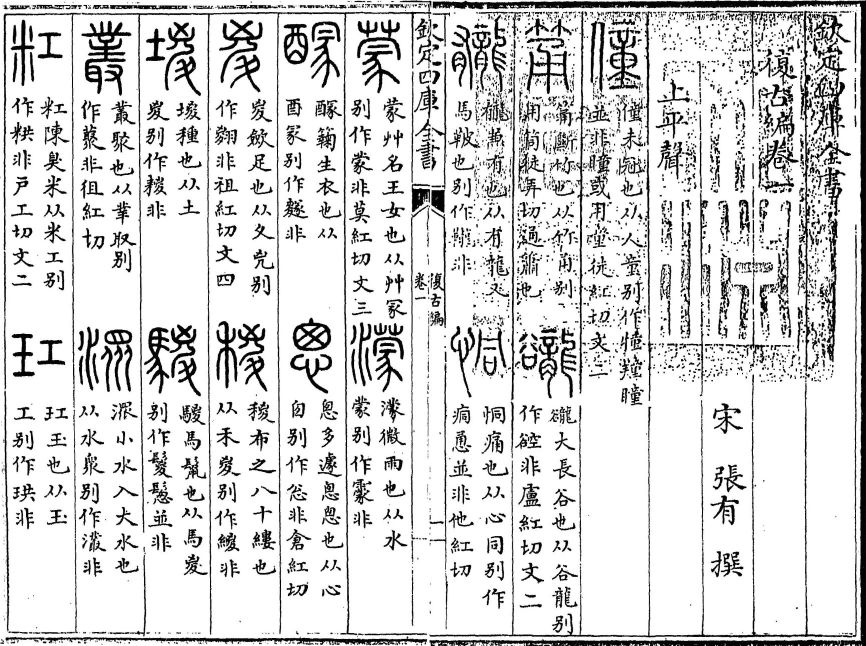Fugubian 復古編 "A reinvestigation of ancient scripts" is a book on Chinese characters written during the Song period 宋 (960-1279) by Zhang You 張有 (b. 1054), courtesy name Qianzhong 謙中. Zhang hailed from Huzhou 湖州 (modern Wuxing 吳興, Zhejiang) and was a grandson of the poet Zhang Xian 張先 (990-1078). He never obtained an office but was a private literatus who was very interested in calligraphy and the ancient script.
His 2-juan long Fugubian was finished in 1113. It advocates to respect the small seal script (xiaozhuan 小篆) whose shape was closer to the original meaning of the characters than the standard script (kaishu 楷書). The Fugubian is arranged like Yan Yuansun's 顔元孫 (d. 714) glossary Ganlu zishu 干祿字書 from the Tang period 唐 (618-907) which discerns three types of characters, namely "correct" ones (zhengti 正體), "commonly used" ones (tongti 通體) and "vulgar" characters (suti 俗體).
 |
The "orthodox" characters are written large and in seal-script style, the explanatory text with hints to pronunciation and "wrong" versions in regular script. The first character, for instance, is 僮 (written in seal script), meaning "an uncapped [i.e. young man], is derived from 人 "person" and the [phonetic part] 童 /dʰuŋ/ (in the fanqie system expressed 徒紅切). It is also incorrectly written 犝, 𦏆 or 朣. The character 童 is also used for the word 瞳 "pupil of the eye". Siku quanshu 四庫全書 edition. |
In Zhang You's eyes the "correct" form was the small seal script form, while all others were "wrong", for instance, 碁 instead of the correct 棊 "chess", or 貽 instead of the proper 詒 "to cheat". Like the Ganlu zishu, the Fugubian is divided into four parts, grouping characters according to the level (shangping sheng 上平聲), rising (shang sheng 上聲), falling (qusheng 去聲) and entering tone (rusheng 入聲). There is an appendix of six chapters on disyllabic words with internal rhyme (Lianmian zi 聯綿字, like pili 劈歷 or pangpei 滂沛), characters whose shapes and pronunciations are similar (Xing sheng xiang lei 形聲相類, like zhong 鐘 "bell" and zhong 鍾 "a wine vessel"), such whose shapes are similar (Xing xiang lei 形相類, like 種 and 穜), such whose sounds are similar (Sheng xiang lei 聲相類, like wan 玩 "to amuse oneself" and wan 翫 "to play with"), characters that are very similar in writing (Bi ji xiao yi 筆跡小異, i.e. writing variants of seal script styles), and such whose lower part is easily written wrong (Shang zheng xia e 上正下訛).
The book explains what characters can easily be confused because of their similarity to each other. It was praised by the Qing-period 清 (1644-1911) scholar Li Ciming 李慈銘 (1830-1895, Yuemantang dushu ji 越縵堂讀書記) for its accuracy which lifts it far about similar books like Guo Zhongshu's 郭忠恕 (d. 977) Peixi 佩觿 or Dai Tong's 戴侗 (1200-1285) Liushugu 六書故.
Zhang You's chapter on words with internal rhymes (Lianmianzi) is interesting, but quite problematic because he was of the opinion that there must be standardized characters for onomoatopoetic words. He also explains in a scholarly way that the name of the mythological ruler Fu Xi 伏羲 must be written 虙虧, the word for "lute" must be written 枇杷 and not 琵琶, or that the monks' clothing kāṣāya must be written 加沙, and not 袈裟.
The Fugubian was during the Song period circulating only in a manuscript version. It was first printed during the Yuan period 元 (1279-1368), and then again in 1882. It is included in the imperial series Siku quanshu 四庫全書.
A revision of the Fugubian, called Zengxiu fugubian 增修復古編, was compiled by an unknown scholar during the very late Song period. The 4-juan long book was allegedly compiled by a certain Wu Jun 吳均. In the preface the author says he mainly used Huang Gongshao's 黃公紹 (jinshi degree 1265) rhyme dictionary Gujin yunhui 古今韻會 as a source, but from the text of the Zengxiu fugubian it becomes clear that his source was rather Zhou Deqing's 周德清 (1277-1365) dictionary Zhongyuan yinyun 中原音韻. A revision was considered necessary because Zhang You's book was seen as to short. The revision version is arranged according to contemporary phonetics, and not to ancient pronunciation, and the character entries are not consistently written in one writing style. It also seems that the lexicon mainly consists of "unorthodox" characters of the type of loan characters (jiajie 假借), and not of "correct" characters.
There is a 4-juan long supplement called Xu fugubian 續復古編 written by the Yuan-period 元 (1279-1368) scholar Cao Ben 曹本, courtesy name Zixue 子學. He hailed from Daming 大名, Hebei, and was aide (cheng 丞) of the district magistrate of Duchang 都昌, then an official in the capital, and then in the local administration of Xinzhou 信州.
His book is not only an extension of the lexicon in Zhang You's 張有 (b. 1054) Fugubian 復古編, but also adds corrections to errors in Zhang You's book. While the Fugubian includes 2,760 characters, the Xu fugubian has 6,049 entries. It repeates Zhang You's important appendixes, and adds to further to the former's six, namely characters with several pronunciations (Zi tong yin yi 字同音異, like 忠 and 忡, or 裏 and 裡), and words with two different characters and the same meaning (Yin tong zi yi 音同字異, like 恫 and 俑 "aches", or 鐘 and 銿 "bell").
The Xu fugubian was finished in 1352 after twenty years of work. It is to be found in the series Suiyatang congshu 邃雅堂叢書.